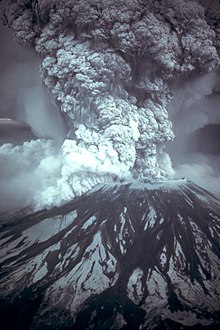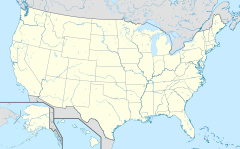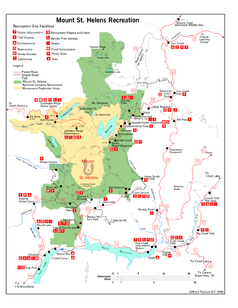Mount St. Helens
| Mount St. Helens | ||
|---|---|---|
|
Mount St. Helens, July 2007 |
||
| height | 2539 m | |
| location | Washington ( USA ) | |
| Mountains | Cascade chain | |
| Coordinates | 46 ° 11 '58 " N , 122 ° 11' 28" W | |
|
|
||
| Type | Stratovolcano (active) | |
| rock | Dazit | |
| Age of the rock | Holocene | |
| Last eruption | July 10, 2008 | |
| First ascent | August 26, 1853 | |
The Mount St. Helens [ ˌmaʊnt sənt ˈhelənz ] is an active volcano in Skamania County in the south of the US state Washington with an altitude of 2539 m . It belongs to the Cascade Range , a volcanic mountain range that extends along the west coast of North America and forms part of the Pacific Ring of Fire . Like all volcanoes in the Pacific Ring of Fire, Mount St. Helens has a particularly high level of explosive energy. Its eruptions are counted among the Plinian eruptions .
The May 18, 1980 eruption of Mount St. Helens is the best observed and studied Plinian eruption to date. Since 1982 the volcano and its surroundings, devastated by the eruption and slowly regenerating, have been designated as a nature reserve of the type of a national monument . The area is administered by the United States Forest Service .
geography
Mount St. Helens is located in the Pacific Northwest of the United States about 50 km west of Mount Adams , 80 km south-southwest of Mount Rainier and about 100 km north-northwest of Mount Hood , the most striking volcanoes in the northern part of the Washington and Oregon states Cascade chain. The distance to Seattle is about 160 km as the crow. Portland , Oregon is 50 miles away as the crow flies.
Its peak today, 2539 m high, rises about 1100 m over the surrounding mountain ridges. The volcanic cone has a diameter of just under 10 km. Mount St. Helens lies entirely in the basin of the Columbia River . Creeks originating on the mountain flow north into the Cowlitz River , west over the Toutle River into the Cowlitz, southwest into the Kalama River and southeast over the Muddy River into the Lewis River or directly into it. The long-term mean rainfall amounts to 1150 mm at the foot to 3550 mm on the exposed slopes.
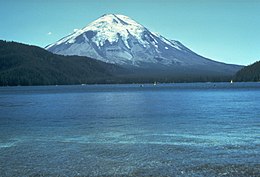
Geology and eruption history
The cascade chain owes its volcanic activity to plate tectonics . Off the coast, the Juan de Fuca plate meets the North American plate and dips below it ( subduction ). The material of the plate melts in the subduction zone and rises as magma through cracks in the earth's crust that arise when the collision occurs.
The history of the eruption of the chimney of Mount St. Helens begins with the first detectable ash deposits , which can be dated to an age of over 40,000 years. A total of nine major eruption phases with a duration of between 5000 and less than 100 years, separated by dormant periods of between 15,000 and around 200 years, could be detected. These periods are based on geological research on the mountain in the 1960s and increasingly in the 1980s and on the methods of geochronology . Due to the small age of the mountain, in addition to investigations of the rock, plant remains in or under the respective lava and ash layers on Mount St. Helens could be dated using C-14 dating for the oldest phases and occasionally dendrochronologically for more recent history.
In the last ice age ( called Wisconsin glaciation in the United States ) up to about 11,000 years ago, the volcanic cone at that time was largely leveled by glaciers . The cone towering up today is no older than 2200 years. It was significantly shaped by an eruption in 1480, which was about five times stronger than the eruption in 1980. This makes Mount St. Helens the youngest of the great volcanoes of the Cascade Range and at the same time the most active of the recent geological period ( Holocene ).
As a stratovolcano (also known as stratovolcano), Mount St. Helens is composed of individual layers of rock. They were deposited on the existing mountain with each eruption and consist of andesite and basalt in the cascade chain . The predominantly regular layers with lava domes interspersed emerged as the ausquellende slowly on the respective surface of lava and dacite exist. Before 1980, the entire summit area consisted of the largest of these Dazite domes.
Because of its young age, weathering and erosion had little time to attack the mountain: Before the eruption in 1980, Mount St. Helens was the smoothest volcano in North America and has been compared to Mount Fuji in Japan . At 2950 m at the time , it was the fifth highest mountain in Washington and remains so after the loss of 411 m.
history
Mount St. Helens is located in the area of the Northwest coast Indian culture . The oldest traces of human settlement are fireplaces, which date back to the 5th millennium BC. To be dated. In historical times the immediate area around the mountain was inhabited by the Klickitat , the wider area by the inland Salish . Both peoples shared a myth about the mountain they called Loo-Wit Lat-kla or Louwala-Clough (mountain of fire or smoking mountain) and the other volcanoes in the area. Because of its regular shape (before the eruption in 1980) they identified Mount St. Helens with the beautiful female spirit Loo-Wit or La-wa-la , around which the two sons of the "Great Spirit", Wy'east ( Mount Hood ) and Pahto ( Mount Adams ) quarreled. The two jealous men (volcanoes) threw stones and liquid fire, destroying not only villages, but also the Bridge of the Gods , a rock bridge over the Columbia River with special meaning in Indian myths, and thus isolating the region north of the river . The “Great Spirit” could only calm down when he turned all three into mountains.
The first Europeans on the George Vancouver expedition saw Mount St. Helens on May 19, 1792 while exploring Puget Sound . Vancouver only gave the volcano a name on October 20, 1792, off the coast, near the mouth of the Columbia River. He named the mountain after the British diplomat Alleyne FitzHerbert, 1st Baron St Helens . There was a minor outbreak in 1800 which was later reported by the Nespelem Indians of the area. The Lewis and Clark Expedition saw Mount St. Helens from a distance in 1805 and 1806, but did not come near it. They noted no signs of recent volcanic activity. In 1831 and 1835, Dr. Meredith Gairdner, a Scottish doctor serving the Hudson's Bay Company in Fort Vancouver , on one eruption and one lava flow. It is more likely that he saw currents of mud and debris, perhaps a small pyroclastic flow .
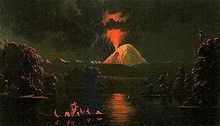
There is a detailed report from 1842 by a pastor who observed a major eruption from Champoeg , Oregon . Volcanic ash fell back to The Dalles , about 80 km southeast of the volcano. Samples of the ash were given to John Charles Frémont on his surveying expedition on the Columbia River the following year . In 1847 Paul Kane painted the mountain with clouds of smoke emerging from a flank volcano about halfway up the cone. Other minor outbreaks were reported in 1898, 1903, and 1921; since they did not leave any volcanological traces, they could only have had a low intensity.
The first ascent of Mount St. Helens took place on August 26, 1853. A mountaineering group, led by a newspaper publisher from Portland , Oregon, reached the summit from the south after climbing three days. Her report in The Oregonian is the first evidence of a crater at the top of the mountain.
Erupted on May 18, 1980
Mount St. Helens has been a dormant volcano since 1857, but erupted again on May 18, 1980 after a series of earthquakes on March 20, 1980. The entire northern mountain peak slid down the slope. Before the eruption, the summit of Mount St. Helens was at 2950 m . Today the summit height of the mountain is 2539 m . An area of around 500 square kilometers was directly affected. 57 people were killed in the eruption, including volcanologist David A. Johnston , who was at an observation post 10 km away and was measuring the gases from a fumarole . About 3 km³ of rock was moved in this eruption.
Ash and gas clouds were hurled up to a height of 18 km, i.e. above the troposphere into the stratosphere . The ash ejection lasted nine hours and was registered three days later in the eastern United States. Some of the ash got into the jet stream and circled the earth in two weeks.
Pyroclastic currents , in which temperatures of over 640 ° C prevailed, raced downhill at a speed of 400 km / h and destroyed all the fauna and flora of the area. Two weeks after the outbreak of the pyroclastic currents, temperatures of more than 400 ° C still prevailed in the strata.
No less dangerous was a lahar , which caused further devastation by mixing the pyroclastic currents with the ice and snow of the upper mountain flank and at a speed of 120 km / h, so that the usual flood levels were exceeded by up to 9 m within a very short time .
Activities after 1980
Volcanic activity on St. Helens continued between 1980 and 1986. A new lava dome formed from Dacite in the crater that was blown open in 1980. Numerous smaller explosions took place during this time. Between 1989 and 1991 there were several minor seismic activities, sometimes combined with minor explosions at the cathedral itself. Later in 1995, 1998 and 2001 swarms of earthquakes were recorded, but no explosions took place.
At the end of September 2004 the activity of the volcano increased again. The phase began with around 200 small earthquakes on the same day, none of which reached 1 on the Richter scale . Their center was directly below the crater and the lava dome. The United States Geological Survey (USGS) issued a warning on September 26, prompting the US Forest Service to close the mountain to hikers and climbers, leaving the road in the sanctuary and visitor centers open. In the last days of September the intensity and frequency of the earthquakes increased.
A small outbreak occurred on October 1, 2004. The eruption began with a cloud of steam and ash , originating from a glacial area in the crater southwest of the lava dome. This cloud was drifting towards the southwest. In Vancouver , Washington and Wood Village , Oregon , about 60 km away , streets, roofs and cars were covered with a layer of fine, black ash. The USGS feared a major outbreak was imminent. On October 2, measuring devices registered rising magma in the mountain, the alert level was raised to the highest value three and a warning was issued of a major eruption within the next 24 hours. The whole sanctuary was evacuated.
Low-frequency quakes continued to be recorded on the night of October 3rd, indicating that magma was moving below the mountaintop. Another steam eruption took place in the morning (local time) of October 4th. The seismic activity continued and reached level three on the Richter scale. After the volcano had repeatedly ejected steam and ash, the USGS reset the alarm status from three to two on October 6th and stated that the existing magma now has only a low explosive power. On October 11th, magma reached the crater surface and a new lava dome was built on the south side of the old dome.
In March 2005 there was another eruption of smoke and ash. The column of smoke was about seven miles high and could still be seen in Seattle . On March 9, volcanic ash fell in Yakima , Washington, about 100 km east of the mountain . In the following years the activity of the volcano decreased again, there were also small, near-surface earthquakes and occasional clouds of steam. Only the lava dome in the crater grew until January 2008 due to slowly expanding lava. In July 2008 the USGS downgraded Mount St. Helens to dormant and warning level zero.
The decreasing activity of the volcano led to a new glacier being formed in the crater since 1986, contrary to the global trend . It was only deformed in the small eruptions in 2004/05, not completely melted off and has been growing again since then.

Regeneration of flora and fauna
At Mount St. Helens, the US Forest Service and the US Geological Survey are researching the repopulation of the landscape devastated by the volcano in various projects. Even in the areas directly hit by ash and blast waves, plants and animals were able to survive under the isolated snow fields. These included low conifers as well as pocket rats , ants and aquatic amphibians . The immediate erosion caused by rain washed away the ash layers in exposed areas so that seeds could germinate and break through the remaining ash. In particular, lupins and the narrow-leaved willowherb were among the pioneering species that spread rapidly in the first summer after the outbreak. Willow bushes were already forming in the summer of 1980 where hillside springs emerged from the rubble .
Arachnids and scavenging ground beetles were the first animals to migrate from the outside into the hostile scree fields. They were brought in by the wind and lived on the bodies of the insects, which were also blown in by the wind and still found no basis for survival. In the first summer, the wind brought an average of 6 milligrams of dry mass of insects per square meter per day, in view of the size of the area that was several tons of biomass in the first year, which were converted by the destructors . Elk deer used the open landscapes as a route for hikes from the first few weeks, feeding on the emerging willows and red alders .
The large and small lakes in the area were heavily acidified by the direct entry of ash, but regenerated after the first two winters. Landslides threw millions of dead trees and other biomass into Spirit Lake , Coldwater Lake, and other lakes. The degradation of the organic matter caused massive eutrophication , which resulted in strong algae growth and a complete depletion of the oxygen dissolved in the water. In the late summer of 1980, almost all of the still waters on Mount St. Helens had overturned . Contrary to the expectation that it would take decades for the nutrient cycle to stabilize again, the rainfall and temperature cycles of two winters were enough to get the lakes going with oxygen and to flush out excess nutrients. Even 30 years after the eruption, hundreds of thousands of tree trunks are still floating on the two large lakes. However, their breakdown is greatly delayed and the waters can cope with the released nutrients.
A few lakes were still covered by ice and snow in May 1980. In them, the aquatic fauna completely survived. Fish, amphibians, water-dwelling insects and other animals began to colonize the newly emerging watercourses as early as summer. At Meta Lake, around 13.5 km from the crater and only protected from the pressure wave by a layer of ice, beavers appeared again in 1985 . Their dams created shallow water areas, which significantly improved the living conditions of many species. Birds quickly used the lake as a source of food.
The positive role of erosion, through which germinable seeds came close to the surface again, was initially not recognized by the scientists. They feared that the massive removal of the ash layers could result in large-scale landslides and silt up the watercourses for a long time. For this reason, grass seeds mixed with a natural adhesive were spread by helicopters in huge quantities on the devastated slopes. However, despite the glue, the seeds were washed away by the precipitate. It formed the food basis for various small rodents , which suddenly multiplied explosively. The forest company Weyerhaeuser saw its young afforestations on the edge of the devastated area endangered and decided to use rodenticides .
For the scientists, the regeneration of the areas affected by the outbreak was an outstanding research object in fault ecology . The direct influence of pressure waves, ash clouds and forest fires on the one hand, the unexpectedly surviving organisms and the succession that set in immediately were and are intensively investigated. The importance of rodents living underground for vegetation development was surprising . The pocket rat Thomomys talpoides digs up the ground, bringing seeds from layers spilled by ash near the surface where they can germinate. Pocket rats' feces played a special role in the rapid development of mycorrhiza , which promoted the growth of vegetation.
After three decades, pioneer vegetation has developed in the deeper and water-rich areas, predominantly of red alder and several types of willow. The trees have reached a height of several meters and have favored the emergence of a dense undergrowth. Drier regions are covered with species-rich grass and shrub vegetation, and in some cases annual flowering plants also dominate. Because of the short vegetation period, the high altitudes are slowly being settled. Purple firs are usually less than a meter tall, short-stemmed grasses and herbs form grasslands .
Mount St. Helens National Volcanic Monument
| Mount St. Helens National Volcanic Monument | ||
|---|---|---|
|
|
||
| Location: | Washington , United States | |
| Specialty: | Volcano and large parts of the areas devastated and regenerating during the 1980 eruption | |
| Next city: | Castle Rock , Washington | |
| Surface: | 445.2 km² | |
| Founding: | August 26, 1982 | |
In early June 1982, a little over two years after the eruption, a member of the House of Representatives introduced a bill to designate the mountain and its surroundings as a National Monument- type protected area . As almost the entire affected by the outbreak area in federal ownership was and already for the Gifford Pinchot National Forest , a National Forest under the administration of the United States Forest Service , was one, there was no resistance and already on 26 August 1982, the sanctuary was dedicated .
The Mount St. Helens National Volcanic Monument covers almost the entire volcano, including the slopes in the south of the summit, which were only slightly affected by the 1980 eruption, and hardly affected areas north of the 1,785 m high Mount Margaret. These include in particular the crater , the mud flows , the debris flows along the North Fork Toutle River , the entire area in which the ash clouds and pressure waves have completely devastated the forest, as well as almost all burned forest areas and the two lakes Spirit Lake and Coldwater directly affected by the eruption Lake.
The Mount St. Helens National Volcanic Monument is accessed from three sides by side roads. The main access is from the west, starting from the small town of Castle Rock , about 100 km south of the capital Olympia on the Interstate 5 highway. The main visitor center is located near the village on Silver Lake and a little more than 55 km from the border of the actual reserve. It is operated by the Washington State Parks and Recreation Commission after the Forest Service lacked funds in 2000 to continue staffing it. The second large visitor center near the park entrance on Coldwater Lake was closed in the fall of 2007 for lack of money. It was only reopened in spring 2014 as an educational facility for events and groups in cooperation with the Forest Service and the Mount St. Helens Institute, which has existed since 1996 . Thus, only the small visitor center at the end of the cul-de-sac on Johnston Ridge remains in the National Monument itself . It contains an exhibition on the geology of the area and the history of the eruption.
The entrances from the east and south lead to the starting points of hiking trails and some viewpoints. On the south flank are the Ape Cave , an approximately 3 km long, 2000 year old accessible lava tube , and the Lava Canyon , a lava flow that was washed out by the Muddy River , exposing the structure of the lava. On the access road there is another visitor center of the Weyerhauser Company, which mainly shows the recultivation measures on their land.
The areas on the outskirts of the protected area little affected by the outbreak are freely accessible to visitors, in the core area and in particular the regeneration areas there are paths . Some areas are designated as priority areas for ecological research and are inaccessible to visitors. Registration with the Forest Service is required for an ascent to the summit . Mountaineers are only allowed to enter the flank and the crater rim, the inside of the crater is blocked.
In view of the financial situation of the Forest Service and the protected area, a political debate about the future of the monument has been going on since the beginning of 2007. Politicians from Washington and various nature conservation organizations suggest upgrading Mount St. Helens as a national park and transferring it to the National Park Service . Other voices are calling for an end to the requirements for research purposes and for the whole mountain to be released for recreational use.
Documentation and artistic processing
The May 1980 eruption was recorded by multiple cameras from the US Geological Survey. The exploration of the devastated areas immediately after the end of the eruptions was also accompanied by cameras. Several documentaries were made from the material . A 25-minute documentary in IMAX format by George Casey under the title The Eruption of Mount St. Helens! came to IMAX cinemas in 1980 and was nominated for an Oscar for best short documentary the following year .
From 1981 comes a docu-drama under the name St. Helens (German titles: Mount St. Helens - Der Killervulkan and St. Helens: Der tödliche Berg ) with Art Carney and David Huffman . The film is based on the real events around the geologist David A. Johnston , who examined the volcano after the beginning of the active phase in March 1980 and died in the eruption in May.
The 1997 disaster film Dante's Peak with Pierce Brosnan in the lead role and directed by Roger Donaldson was based on the eruption of Mount St. Helens. The producers were advised by scientists from the USGS and were able to depict the processes and effects of a volcanic eruption largely correctly.
The American composer Alan Hovhaness pays homage to the mountain in his eponymous Symphony No. 50, op. 360 (1981/82). The three-movement work musically reproduces the majestic impression of the mountain in the first movement, is reminiscent of the Spirit Lake destroyed during the eruption, and concludes with a sound-painting implementation of the eruption.
literature
- Patricia Lauber: Volcano: The Eruption and Healing of Mount St. Helens . Aladdin Books, New York, NY 1993 (first edition: Bradbury Press, New York, NY 1986), ISBN 0-689-71679-6 (English).
Web links
- United States Forest Service: Mount St. Helens National Volcanic Monument (official website, English)
- Mount St. Helens in the Global Volcanism Program of the Smithsonian Institution (English)
- US Geological Survey: Mount St. Helens (English)
- US Geological Survey: Website of the 30th anniversary of the outbreak (English)
- Vic Camp: Mt. St. Helens , How Volcanoes Work , San Diego State University, Dept. of Geological Sciences
- Stromboli.net: Volcanoes of the World - Mount St. Helens
- McKenzie Funk: Mountain Transformed - Thirty years after the blast, Mount St. Helens is reborn again. National Geographic Magazine, May 2010 (English, feature article about the regeneration of flora and fauna 30 years after the eruption, with picture gallery and video)
Individual evidence
- ↑ a b c USGS : Mount St. Helens Factsheet
- ^ Robert I. Tilling, Lyn Topinka, Donald A. Swanson: Eruptions of Mount St. Helens: Past, Present, and Future . US Geological Survey, Special Interest Publication, 1990.
- ↑ This chapter follows the presentation in USGS: Description - Mount St. Helens Volcano, Washington
- ↑ Newspaper article by Thomas J. Dryer: First Ascent of Mount St. Helens, Washington, August 26, 1853 . In: The Oregonian. September 3, 1853.
- ↑ This chapter is based on Robert I. Tilling, Lyn Topinka, and Donald A. Swanson: Eruptions of Mount St. Helens: Past, Present, and Future . US Geological Survey, Special Interest Publication, 1990.
- ↑ USGS: Warning messages and recommendations 1980–1999 (PDF; 965 kB)
- ↑ The representation is based on the official reports of the USGS: Questions and Answers About the 2004-2008 eruption .
- ↑ USGS: message dated October 2, 2004
- ↑ USGS: overview of reports from October 6, 2004
- ↑ USGS: Monitoring Report, February 2008
- ↑ USGS: Mount St. Helens Returns to Slumber , July 10, 2008.
- ↑ USGS: Press summary September 2007 (PDF; 45 kB)
- ↑ Unless otherwise stated, this chapter is based on the USFS report: Biological Responses to the 1980 Eruption of Mount St. Helens
- ↑ a b Bruni Kobbe: Return of Life. In: Image of Science. Leinfelden-Echterdingen, Konradin Medien, edition 10/1991, pp. 84–87.
- ↑ Virginia H. Dale, Frederick J. Swanson, Charles M. Crisafulli: Disturbance, Survival, and Succession - Understanding Ecological Responses to the 1980 Eruption of Mount St. Helens. In: Virginia H. Dale, Frederick J. Swanson, Charles M. Crisafulli (Eds.): Ecological Responses to the 1980 Eruption of Mount St. Helens. Springer, 2005, ISBN 0-387-23868-9 , pp. 3-13.
- ^ Douglas C. Andersen, James A. Macmahon: Plant Succession Following the Mount St. Helens Volcanic Eruption: Facilitation by a Burrowing Rodent, Thomomys talpoides. In: American Midland Naturalist. Vol. 114, no. 1 (July 1985), pp. 62-69.
- ^ Michael F. Allen, Charles M. Crisafulli et al.: Mycorrhizae and Mount St. Helens: Story of a Symbiosis. In: In: Virginia H. Dale, Frederick J. Swanson, Charles M. Crisafulli (Eds.): Ecological Responses to the 1980 Eruption of Mount St. Helens. Springer, 2005, ISBN 0-387-23868-9 , pp. 221-231.
- ↑ Washington State Parks: Mount St. Helens
- ^ Mount St. Helens Science and Learning Center: Web site
- ↑ USFS Mount St. Helens National Volcanic Monument: Attractions South Side. US Forest Service , archived from the original on October 24, 2010 ; accessed on July 13, 2012 .
- ↑ USGS: Mount St. Helens Points of Interest: Lava Canyon
- ↑ National Volcanic Monument: Climbing Mount St. Helens
- ^ National Parks Conservation Association: Mandates, Economic Impacts, and Local Concerns - Who should manage Mount St. Helens? ( Memento from September 20, 2015 in the Internet Archive ) (PDF; 189 kB)
- ↑ Clash Over Rebirth of Mt. St. Helens . New York Times, August 18, 2009, page D1 (also online )



